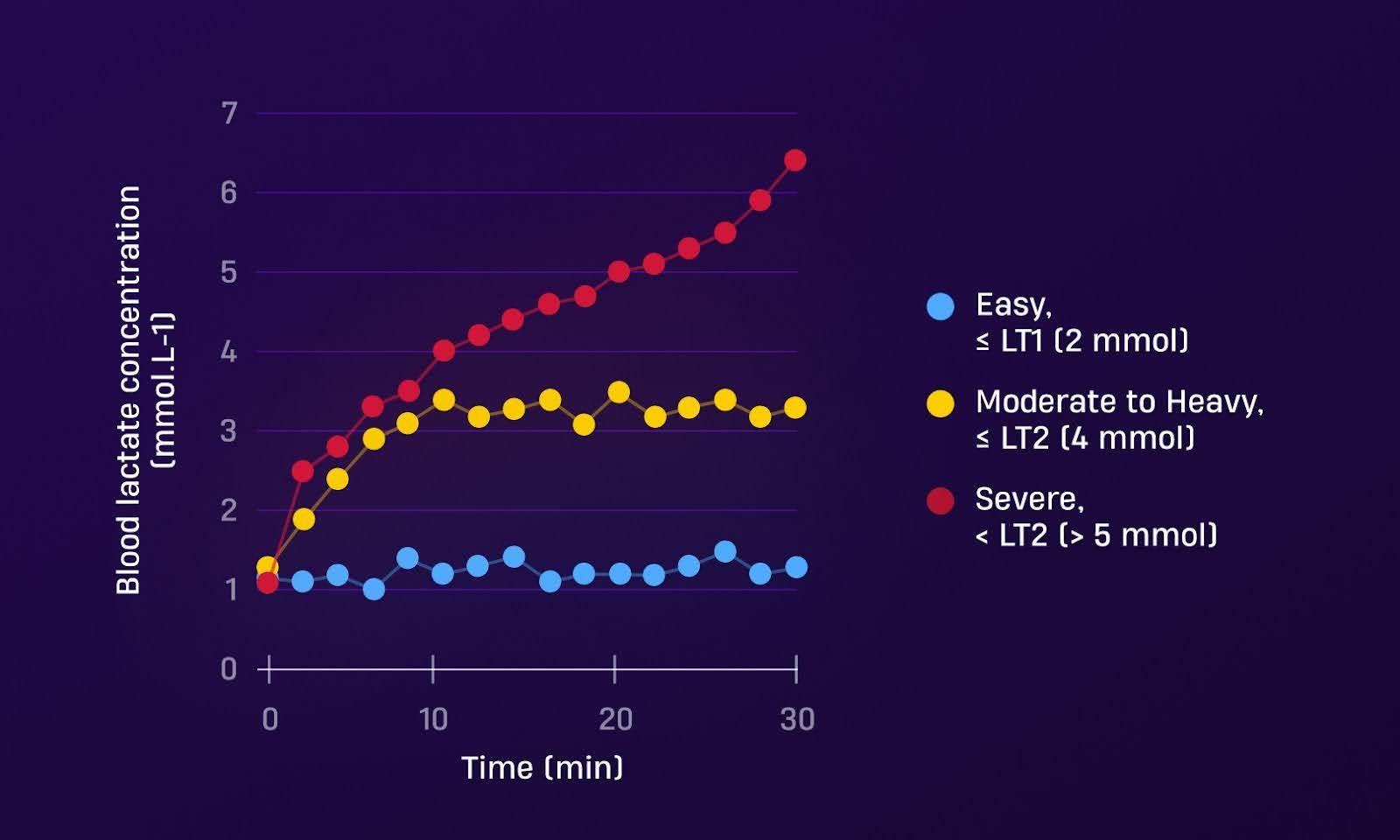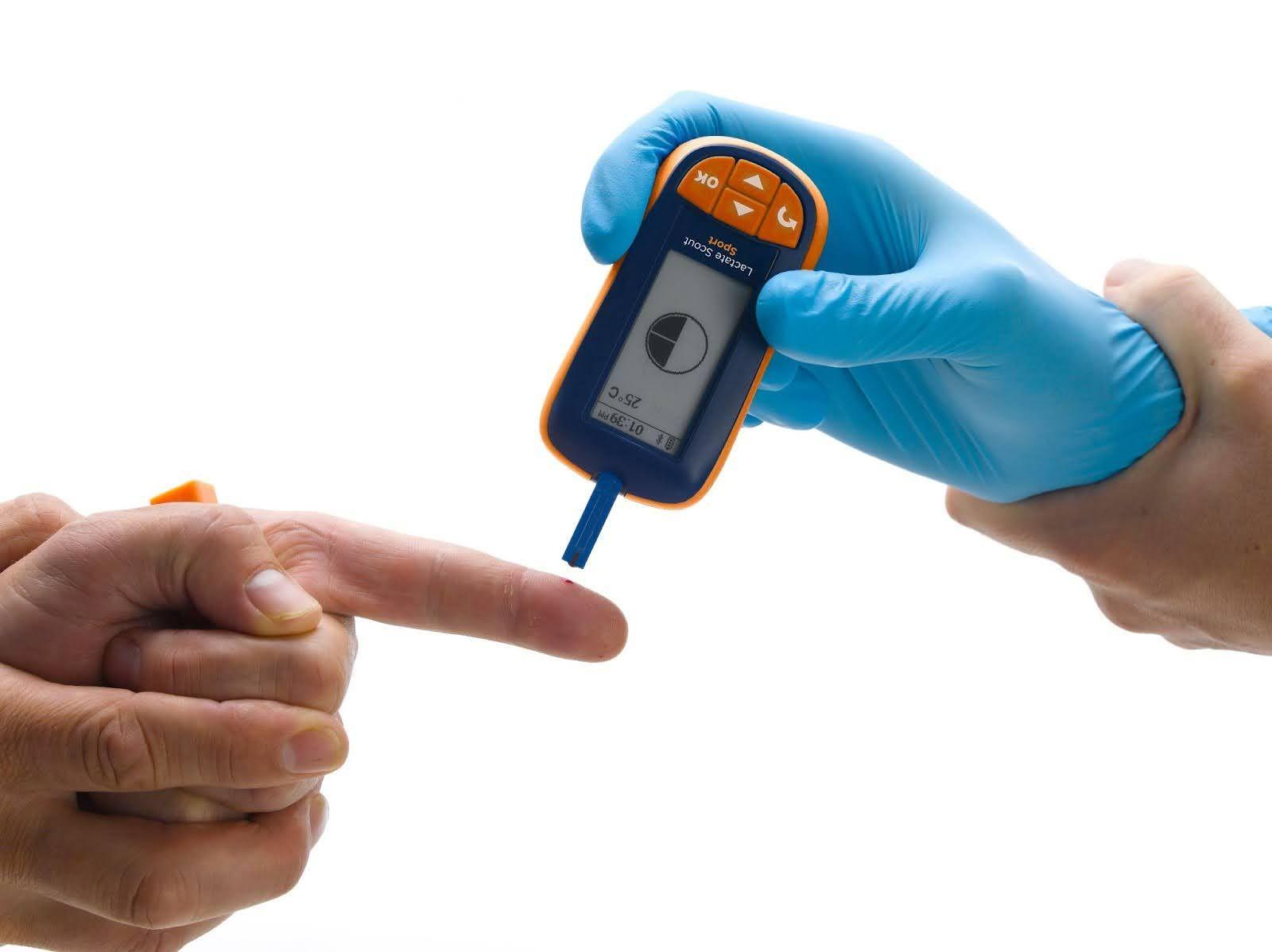
Lactate has been studied in sports physiology for a long time and is routinely measured, especially in endurance athletes. In the late 1970s, the term “lactate threshold” was introduced by German sports scientist Alois Mader, who conducted the first fundamental research to define the lactate threshold at an average of 4 mmol of lactate per liter of blood. He also applied the threshold concept to define training zones.
For a long time, lactate was considered a metabolic waste product that accumulates in muscles during intense physical activity and leads to fatigue. Recent findings have shown, however, that lactate is not a waste product, and is not the primary cause of physical fatigue. In fact, it’s been proven that lactate plays many important roles in metabolism – especially as an energy source for muscles and the heart, and in cell signaling.
In cycling, physiological performance and capacity play a very important role. The lactate threshold concept provides valid information about different training zones and the specific metabolic pathways involved, such as fat or carbohydrate metabolism, or VO2 Max development.
One of the big advantages of the workouts on the ROUVY app is the high quality and precision of the training with respect to power output. You can train very specifically, for example targeting your lactate threshold power or your maximum oxygen uptake, with specially designed workouts where you’re not troubled by traffic or other outdoor factors.
To get the most out of your training, it’s advisable to know your personal training zones and intensities based on lactate measurements, as they reflect your individual physiology far more accurately than a standard FTP test.
What is lactate, and where is it produced?
Lactate is produced in cells during a process called glycolysis. When carbohydrates are broken down, lactate is formed. This is then converted into acetyl-CoA, which enters the Krebs cycle for further aerobic metabolism (with oxygen), resulting in ATP (adenosine triphosphate). ATP is the energy required for muscle contraction.
Lactate is often mistakenly referred to as lactic acid, and its association with acidity is frequently misunderstood as the root cause of fatigue and muscle soreness. This is not entirely accurate, however. In fact, the lactate molecule itself cannot be directly converted into an acidic compound. The reason lactate is associated with acidity lies in the following biochemical process:
Lactate is actively transported out of the cell via a protein transporter known as MCT (monocarboxylate transporter). This transporter binds to lactate and carries it across the cell membrane. Importantly, MCT also transports hydrogen ions (H⁺) out of the cell along with lactate. These hydrogen ions are responsible for lowering the pH level and are the true contributors to increased acidity.
Recent studies show that significantly more lactate than pyruvate is formed during glycolysis, and lactate is the main product used in subsequent metabolism via the Krebs cycle.
During physical exertion, most lactate is produced in the working muscles, where the rate of ATP and energy turnover required for muscle contraction is high.
In very intense efforts with a correspondingly high energy demand – such as short sprints – the lactate is transported directly out of the cell after glycolysis and is not further metabolized in the Krebs cycle. The measurable lactate in the bloodstream rises sharply. This is referred to as anaerobic metabolism (without oxygen), which produces significantly less energy in the form of ATP overall.
Compared to carbohydrate metabolism, beta-oxidation (the breakdown of fats) produces acetyl-CoA, which also enters the Krebs cycle and results in ATP production.
This is typically why athletes with a very high fat-metabolism capacity show lower lactate levels.
In addition to muscles, lactate is also an important substrate for the liver, which is a crucial organ for regulating blood-sugar levels. A drop in blood sugar can lead to a performance crash – something many know as “bonking” or “hitting the wall.”
Lactate serves as an energy source for the liver and is used in a process called gluconeogenesis to produce new glucose. This is an efficient way to maintain blood glucose levels during physical exertion.
Lactate thresholds
In sports science, we often see mention of two lactate thresholds: LT1 and LT2.
LT2, the lactate threshold or "anaerobic threshold," is the point where lactate production equals lactate clearance (via the Krebs cycle). This is the maximum intensity where a lactate steady state exists – in other words, no rising accumulation yet. On average, this occurs at around 4 mmol/L. It's important to note that the established 4 mmol/L threshold is an average value. Individually, the maximum lactate steady state can be significantly lower or higher.
LT1, the “aerobic threshold,” is the point where lactate begins to rise significantly. This occurs during low-to-moderate-intensity training focused on building aerobic metabolism/fat metabolism. Improving the aerobic threshold relative to performance is a key goal for endurance athletes. LT1 can be developed with Zone 2 training (under 2 mmol/L of lactate).
These two thresholds are particularly important in endurance sports and cycling.

The capacity to burn fat for fuel is crucial for all long-distance events (>2 hours). This metabolic pathway and efficiency are developed during training sessions with a relatively low amount of glycolysis (CHO consumption), which can be detected at an intensity under or at the start of lactate production (LT1).
For cycling races or endurance rides, LT2 plays a crucial role as it marks the upper limit of intensity or speed you can sustain. Any intensity over your LT2 will result in lactate accumulation and pH reduction, which will decrease your performance. So LT2 provides valuable information for your race strategy in terms of intensity (of course, in relation to the duration of the event).
The information above makes it clear that lactate can provide valuable insights into your metabolic and physiological capacity – information that cannot be obtained via heart rate or other external measurements.
LT2, FTP and VO2 Max
Measuring your lactate threshold is the most precise way to determine your endurance and cycling performance and define training zones based on physiological/metabolic data.
The downside of lactate testing is that it either requires visiting a performance lab or having the necessary equipment to conduct the tests yourself.
As a shortcut, the Functional Threshold Power (FTP) test is non-invasive and can be performed at home or during a training ride without any special equipment beyond a power meter. In general, there is an average correlation between the maximum power output over 1 hour and the maximum lactate steady state (LT2).
Detailed comparisons of FTP tests and lactate tests often show that FTP overestimates the measured LT2. This is because you can exceed your LT2 power output for a 60-minute period (including lactate accumulation).
Because an all-out test over an hour is very demanding, the standard test protocol is shortened to 20 minutes, and the maximum average power is multiplied by 0.95 to compensate for the shorter duration. However, evaluating your power over 60 minutes remains the most precise way to determine your FTP.
VO2 Max, your maximum oxygen uptake capacity, has a long history in sports science. The first tests to determine VO2 Max go back more than 100 years.
The importance of VO2 Max is based on the physiological fact that O2 delivery to the working muscle is the limiting factor of aerobic capacity. The Krebs Cycle (aerobic metabolism of fats and carbohydrates) depends on oxygen availability. The more oxygen available, the higher the metabolic turnover of aerobic energy metabolism.
VO2 Max is often used to assess the overall endurance capacity of an athlete. It is precisely measured in a short incremental step test, usually lasting 10-15 minutes, focusing purely on maximum performance output.
The downside, compared to lactate testing, is that you don’t get steady states for different power outputs. So, detailed evaluation of different intensities or training zones is difficult.
How to measure your lactate threshold
To identify your maximum lactate steady state or threshold, you need to perform a step test with increasing intensities. There are two methods.
The first way is to visit a professional performance-diagnostics laboratory.
There, you will go through a step-test protocol, for example, starting at 90 or 120 watts and increasing every 5 minutes by 30 watts until exhaustion. The protocol can vary between institutions or labs.

Lactate is measured at the end of each stage with a small drop of blood from your fingertip or earlobe and analyzed using lab devices such as the Biosen C Line.

The second method is to execute the step-test on your home trainer or on ROUVY by programming the session in advance. There are mobile lactate meters available, such as the Lactate Scout Sport, which provide reliable lactate-level readings. With the gathered data and available software, you can determine your individual lactate threshold.
Tips to ensure accuracy:
- Avoid short stages.
- Stages of 5 minutes or longer are preferred for accurate intensity readings.
- Use your own bike/setup.
- Record power and heart rate for comprehensive data.
How to implement lactate into your cycling training
Lactate is a reliable parameter for cyclists to define individual workloads and metabolic processes.
It is measured in mmol per liter of blood. In healthy individuals at rest, levels range from 0.6 to 1.2 mmol/L.
During low-intensity exercise, levels are around 1.5-2.0 mmol/L.
As intensity increases, levels steadily rise to about 3-5 mmol/L.
Peak values for examples in sprinting can exceed 20 mmol/L.
Lactate measurement is especially useful in performance diagnostics, either in professional labs or home setups.
Lactate gained attention in training through its connection to durability, which describes an athlete’s performance capacity in the later stages of a race or training session. Practically speaking, lactate can be measured during training to check whether training zones or intensities based on earlier performance tests still apply after 3-4 hours of exertion.
For example, in Zone 2 base training, you can confirm whether you are still in the correct range at the end of a long ride. Conversely, you can verify your power output in a high-intensity interval session when targeting threshold power or even VO2 Max.
A broad selection of targeted workouts on ROUVY is available. You can easily check your lactate levels with a mobile meter and ensure the best possible outcome from your training.
Training zones and lactate
Determining your maximum lactate steady state (LT2) forms the basis for defining individual training zones. Based on LT2 intensity, a 5-zone model might look like this:
- Zone 1 (Recovery): Approximately 1-1.5 mmol/L.
- Zone 2 (Fat metabolism): Approximately 1.5-2.0 mmol/L.
- Zones 3-4 (High-intensity base – race pace): 2-4 mmol/L.
- Zone 5 (VO2 Max, high intensity): Above LT2.
In most endurance sports, it is appropriate to include all zones in your training schedule. Depending on your goals and the session’s objective, lactate provides reliable feedback on energy metabolism, physiological load and pathways. Here are some guidelines:
- Base training typically falls in Zone 2.
- Race-specific or threshold training targets Zones 3-4.
- Zone 5 training improves VO2 Max, which is essential for aerobic capacity.
Optimal training requires a mix of intensities, however, and the inclusion of recovery, nutrition and optimal hydration.

A good rule of thumb is the 80:20 rule. Do 80 percent of training below LT2, and do 20 percent of your training above LT2. This approach helps prevent overtraining and supports balanced performance development.
Key takeaways on lactate
Here are four points to keep in mind:
Lactate is continuously produced, even at rest and at low intensities.
Lactate has many vital roles in the body and is not the direct cause of fatigue.
Your lactate threshold (LT2) is the point where production equals elimination.
And finally, blood lactate levels are a precise indicator for determining and managing training intensity and targeting specific physiological pathways.









